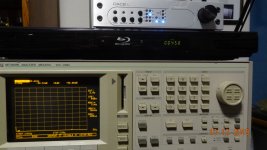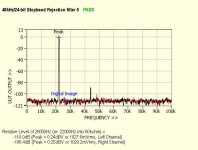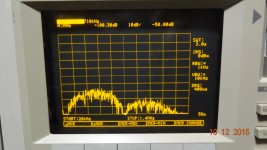Richard- Application is really important for these concepts. If you are using this with an early non-oversampling DAC setting the FC low is important but 20 KHz may be too low since the sample rate is 44.1 KHz and the images are all above 44.1 KHz.
If the player is truly non-oversampling the images start around 24kHz i.e. the audio bandwidth below the sample rate.
Me too - I've experimented with elliptic, Chebyshev and quasi-elliptic passive filters to very good effect.However I have had really positive results using a passive LC filter to remove the image before the external circuitry. I have always thought that an active filter to remove the HF stuff that opamps and analog circuitry has problems with was naive.
Richard - you'll need a bit more than just +1dB to overcome the NOS droop at 20kHz. Ah, re-reading I see your CD player probably isn't NOS so ignore this.
Last edited:
I was joking, Richard. I don't care for a bump of 2dB at 20Khz. For txwo reasons: too old to hear so high, and my horn has a bandwidth limited at 15KHz, it could help-it.It will be slightly better after I build from bread-board to something usable. But even if I could hear it... it would sound a tiny bit brighter with anything that high up. But bright sound not sound the same as distortion which I am listening for.
RNM
For an all passive filter the frequency response looks great. If you do get he chance the phase plot should be interesting.
For an all passive filter the frequency response looks great. If you do get he chance the phase plot should be interesting.
You are going over old ground... i am well past that. Didnt you see the output spectrum I showed here? There are also idle tones seen. I would like to think none of us have to listen to such gear... but apparently, we do. My CD player tested for extraneous HF noises is the Alesis Mastering CD recorder.
THx-RNMarsh
Link? I obviously missed it. I have not seen issues in the DAC's I have looked at but its not a large set. My feeling would be to replace the DAC with a decent external one. They can be had on eBay for peanuts. Screwing around trying to fix a bad implementation seems like a low ROI effort.
I think there is no need to filter so close to the bandwidth upper limit of 20KHz, as long as your system is able to deal with high slew-rates. The high frequencies noises will be amplified as-it, without other artifacts, don't you think ?I was joking, Richard.
If your amp is (internally) flat up to 1MHz, i believe a margin of 10 is high enough, and i would chose to filter at 100KHz.
Link? I obviously missed it..
http://www.diyaudio.com/forums/loun...ch-preamplifier-part-ii-7635.html#post4527009
Richard wants good noise attenuation by 90KHz, so starting the roll off just above 20KHz seems a very logical starting point. Plus there is an interesting idea he is testing.
In the studio, anyone with an ear skipped the converters on the Masterlink and used external ones. As a storage device it was good, as a conversion device or dsp it sucked.
Alan
Alan
NOW you tell me.
But that isnt the real point here.... but do some amps do better dealing with out of band HF junk than others.... notably the VFA when the feedback starts to decrease and non-linearity increases above audio range.
I have BenchMark ADC and DAC-2 here - BTW.
THx-RNMarsh
But that isnt the real point here.... but do some amps do better dealing with out of band HF junk than others.... notably the VFA when the feedback starts to decrease and non-linearity increases above audio range.
I have BenchMark ADC and DAC-2 here - BTW.
THx-RNMarsh
The idea fits into a lot of places..... why many designers think it sounds worse if the amp with nfb has narrow or much limited freq range --- high distortion above the band-pass. Why wide open-loop design sound better and why high SR sound better. All most readily and easy to dealt with (including stable) with CFA design. > Why many designs do not sound good with CD as source. Why some DAC sound better than others. When equipment is tested individually, the audio freq range distortion is very low. ETC. ETC.
THx-RNMarsh
THx-RNMarsh
no gremlins
Only, a low level idle tone at about -90db isnt too bad. What make/model is this?
THx-RNMarsh
http://www.diyaudio.com/forums/loun...ch-preamplifier-part-ii-7635.html#post4527009
Richard wants good noise attenuation by 90KHz, so starting the roll off just above 20KHz seems a very logical starting point. Plus there is an interesting idea he is testing.
Now I see what the fuss is about. That spectrum is completely typical of a DAC without an image filter (that's really cutting corners). Somewhere I have the same spectrum photo before and after a simple LC filter. Without much effort all the junk was reduced by 70+ dB.
What is the utility of that "mastering" box today?
Sorry, I got that wrong. The first set of images is inverted, so they start from 44.1-f, where f is the cutoff frequency of the anti-aliasing filter used before the ADC.DF96 said:Images start from around 22.052kHz (assuming the input rolls off at 20Hz).
That is correct.abraxalito said:If the player is truly non-oversampling the images start around 24kHz i.e. the audio bandwidth below the sample rate.
That would depend on whether you wish to achieve signal reconstruction, or have images masquerading as percussive musical content.Esperado said:I think there is no need to filter so close to the bandwidth upper limit of 20KHz, as long as your system is able to deal with high slew-rates. The high frequencies noises will be amplified as-it, without other artifacts, don't you think ?
If your amp is (internally) flat up to 1MHz, i believe a margin of 10 is high enough, and i would chose to filter at 100KHz.
yes, but...That would depend on whether you wish to achieve signal reconstruction, or have images masquerading as percussive musical content.
The inertia of your tweeters are high enough to smooth the signal. Your DAC was supposed to do-it long time before, with acurate oversampling and low pass filters. Son an analog low pass filter at the input of any amp is supposed to be here to filter only the evils introduced by the analog connecting cables, with various noises due to HF, AC ground leakeages etc...
Not really much utility in the Masterlink today. Many other ways to capture and store 24bit material are handy, which wasn't necessarily the case earlier.
In the studio it is often handy to have a device that will capture the mix in real time external to all other equipment. In the "old days" that was the two track tape recorder, in the digital age it can be a separate device such as the Masterlink, an independent computer, or just another input on the playback computer/DAW. The one thing the Masterlink is missing as a "modern" device is the ability to go in and move the file out of the hard drive without playing it out. Not desirable in todays world.
Alan
In the studio it is often handy to have a device that will capture the mix in real time external to all other equipment. In the "old days" that was the two track tape recorder, in the digital age it can be a separate device such as the Masterlink, an independent computer, or just another input on the playback computer/DAW. The one thing the Masterlink is missing as a "modern" device is the ability to go in and move the file out of the hard drive without playing it out. Not desirable in todays world.
Alan
And, if you take that same CD/DVD/3D player and run it thru an 1800-2000 USD$ converter via coax/digital I/O ports, you get No HF trash to cause increased distortion.

The Alesis was 800 USD$ new and the CD/DVD/3D player is about 300-350 USD. Used ones shown on eBay are about half the new price.
I'll also check some other players but there might be a general price point you dont want to fall below to get the max performance; I wish we knew which were the exceptions but magazines and equipment mfr do not test above 20-30KHz. You are on your own. But might ask for such info before you buy from mfr. If budget is tight, an external LPF is cheap enough to make.
THx-RNMarsh

The Alesis was 800 USD$ new and the CD/DVD/3D player is about 300-350 USD. Used ones shown on eBay are about half the new price.
I'll also check some other players but there might be a general price point you dont want to fall below to get the max performance; I wish we knew which were the exceptions but magazines and equipment mfr do not test above 20-30KHz. You are on your own. But might ask for such info before you buy from mfr. If budget is tight, an external LPF is cheap enough to make.
THx-RNMarsh
Last edited:
And, if you take that same CD/DVD/3D player and run it thru an 1800-2000 USD$ converter via coax/digital I/O ports, you get No HF trash to cause increased distortion.
$ = performance, maybe we are in the land of reversible cups and sanitary pedestals.
- Status
- Not open for further replies.
- Home
- Member Areas
- The Lounge
- John Curl's Blowtorch preamplifier part II

